In this article we will look at several ways to disable verification hard drive(HDD), which starts every time you turn on or restart the computer.
The reason most often is that the system flags HDD as in "dirty". This occurs due to improper shutdown of the computer, violations in the file system, or damage to the hard drive itself.
In order to fix this problem, you need to do the following:
1. Run a full disk scan.
Open "My computer" =>
right-click on the disk that is constantly being scanned =>
from context menu select "properties" =>
then on the tab "service" click the button "Run check"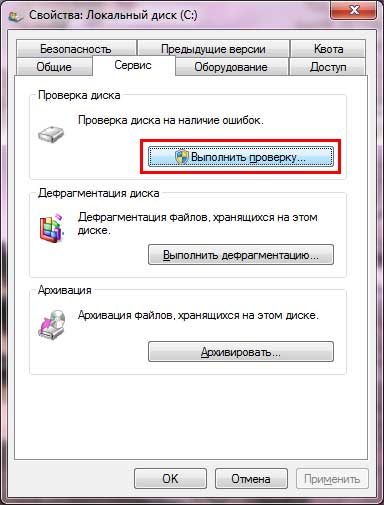
in the window that opens, check all the boxes and click “ Launch».
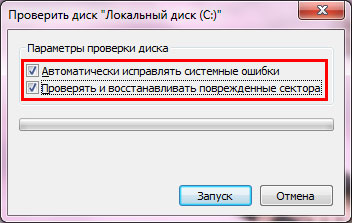
If selected system disk, then you will be asked to perform a check the next time the system boots - we agree and reboot the computer. We are waiting for the verification process to complete.
If the problem remains, move on to the next point;
2. Disable disk check.
Press the key combination Win-R or Start => All programs => Standard => Run => enter the command cmd -> click OK. In the window that opens, enter the command chkntfs /X C: (Where C: - the name of the drive that is constantly being checked).
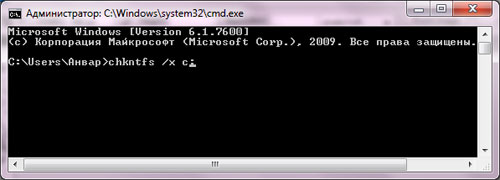
The check is now disabled. If you want to turn it on again, you need to type the command chkntfs /D.
CHKNTFS - enable/disable hard drive check on reboot
Displays or changes disk check options during boot.
- CHKNTFS volume: [...]
- CHKNTFS /D
- CHKNTFS /T[:time]
- CHKNTFS /X volume: [...]
- CHKNTFS /C volume: [...]
volume- specifies the drive letter (followed by a colon), mount point, or volume name.
/D- restores standard computer settings; all disks are checked upon boot and CHKDSK runs when errors are detected.
/T:time- changes the countdown AUTOCHK for the specified period of time in seconds. If no time is specified, shows the current setting.
/X- excludes standard disk check at boot. Information about previously excluded drives is not saved.
/C- requests to perform a disk check at the next boot; if errors are detected on the disk, it starts CHKDSK.
If no parameters are specified, CHKNTFS Displays either the status of the error detection bit for the disk or whether it will be checked at the next reboot.
Hello friends! Well, it’s time to publish another useful lesson. Right here and now I will tell you about checking the disk, or rather, about how to disable automatic disk check, which runs at boot time operating system.
You may be wondering why you should do this; it takes a few minutes, and they are not checked often. If you look at all this on the one hand, then everything is so, but on the other hand, this is not always the case. I recently came across two computers in which, for unknown reasons, a disk check (chkdsk) appeared every time the PC was booted.
No matter how many times I waited for the test to finish, after the next reboot of the PC, the image with the start of the test of one of the sections appeared on the screen again. After several hours of searching for the problem, nothing brought the desired result, not even me, but the test showed that everything was fine with the hard one. So after this I I decided to just disable automatic disk check, so that it does not bother the user who contacts me.
I would like to note that sometimes the constant launch of disk check is associated with a flash drive inserted into the computer. Therefore, first of all, make sure that you do not have any external drive inserted into your computer.
If it’s not a flash drive, then let’s figure out how to disable automatic disk check (chkdsk) and get rid of wasting time when booting the system.
Disable automatic disk check or chkdsk
As I mentioned in most previous articles, many system-related settings can be changed in the system registry, which we will now have to use.
As usual to get started.
Let's take this path:

Now we turn to the right window where we find the key with the name “ BootExecute" You can immediately see that the opposite value is set to “ autocheck autochk *", where the first two words trigger a disk check, and " * " means that all disks installed in the computer will be checked.
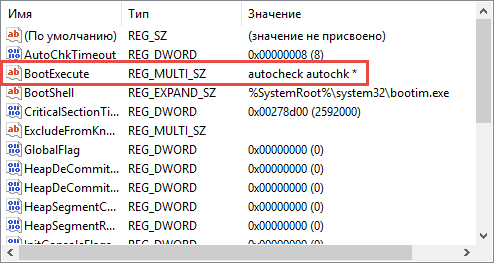
By changing this value, we get what we want. To do this, simply double-click on “ BootExecute"And there in the line that appears, before the asterisk, write in the following letters: " /K:C" Just " /K"and is responsible for disabling automatic disk check at the moment Windows startup. Well, as you understand, the second half of the value is the drive letter that will be ignored. For a visual example, I’ll show you what the “BootExecute” value should look like:
autocheck autochk /K:C *
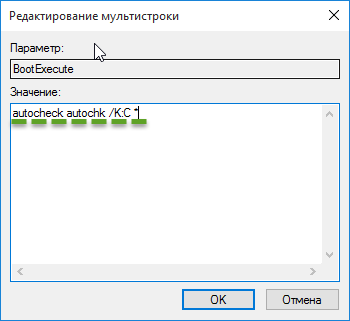
To disable other drives, such as D, you simply need to change only the letter. If you need to disable automatic checking on both disks, then the required value should look like this:
autocheck autochk /K:C /K:D *
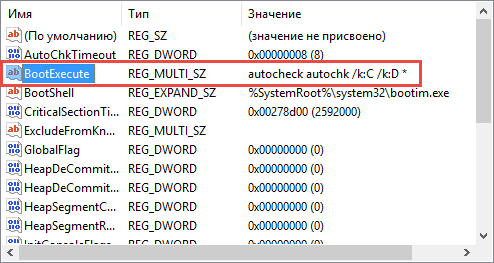
If you suddenly decide to return to previous settings, then just change the value to the standard one that was originally set:
autocheck autochk *
After that, my problems were solved, the disk was no longer checked, and the users were satisfied. Therefore, by disabling automatic disk check when Windows boots, thus, perhaps even without fully understanding the essence of the problem, you can get rid of the long boot time of your system.
P.S.. Feel free to sign up for free lessons and join us in
Instructions
Use the Chkntfs command - this will allow you to cancel check disk at subsequent system boots. The syntax for this command is as follows: Chkntfs /x Y: (Y: is the hard drive letter). You will see a message about the NTFS system being used.
Every time the operating system boots, it automatically starts Chkdsk utility. This utility scans your hard drive for errors and possible malfunctions file system. Of course, there is nothing wrong with this, but the system boot speed will decrease. Meanwhile, this procedure can be disabled, thereby increasing the OS loading speed.
You will need
- - a computer with Windows OS.
Instructions
To disable scanning of the system disk, follow these steps. Click Start. Select All Programs, then Accessories. Among standard programs there is "Command Line". Launch it.
Next, at the command line, enter Chkntfs /X C, where C is the system drive letter. If your system drive has a different letter, then, accordingly, you need to register it. After entering the command, press Enter. Close the command prompt. Automatic scanning of the system partition is now disabled. In the same way you can disable automatic check other hard drive partitions. Just at the end of the command you should write the letter of the hard drive partition for which you want to disable scanning.
Another way to turn off check- This is to edit the system registry branch. At the command prompt, enter regedit. After a second, the Registry Editor window will open. On its left side there is a list of the main sections of the system registry. Find the HKEY_LOCAL_MACHINE section among them.
Click on the arrow next to the name of this section. Repeat the procedure near the SYSTEM subsection. Thus, open the sections in this order: CurrentControlSet/Control/Session Manager. There is no need to open Session Manager; select it with a left mouse click.
After selecting the last section, branches for editing will be available in the right window. Find among them the branch called BootExecute. Double-click on it with the left mouse button. Now you can edit it. All you need to do is add the /K:C option before the asterisk. Ultimately, the edited branch will look like this: autocheck autochk /k:C. Save your changes. After this, disk check will be disabled.
When the operating system boots, one of the last items that appears is the welcome screen. As such, it is merely a decoration and signifies that the login was successful. The welcome screen may appear immediately, but if there are several users on the system, it will appear only after logging in (authentication) to the system. Some operating system users claim that the welcome screen does not play a major role. Moreover, they consider it a secondary element (atavism) that can always be removed. How to do it? Read on.
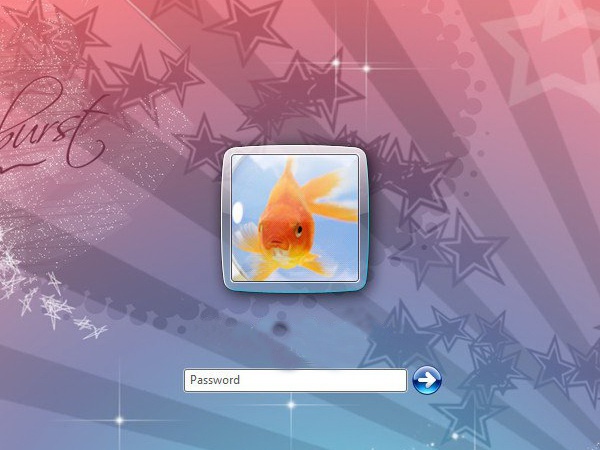
You will need
- Use system settings operating system.
Instructions
Click the "Start" menu - select "Run" - enter the value "gpedit.msc". In the window that opens " Group Policy"Select the folder "Computer Configuration" - "Administrative Templates" - "System" - "Login" - select the file "Always use classic login." A window for this file will open. On the Option tab, set it to Enabled, then click Apply and OK.
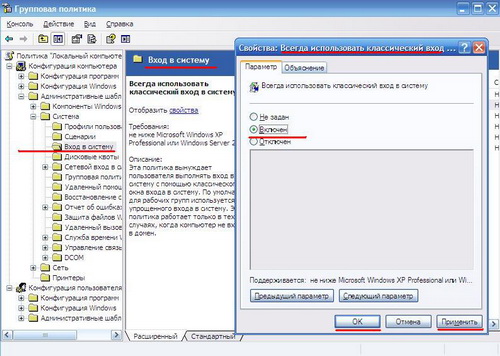
In order to remove the welcome screen, you need to open a text editor and create a new document. In the body of this document, place the following lines:
Windows Registry Editor Version 5.00
"LogonType"=dword:00000000
After that, click the “File” menu - “Save as” - name the file “Greeting.reg” - click “Save”. After that, run the file - click “Yes” in the dialog box.
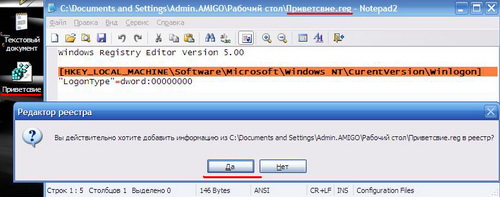
Restoring the welcome window display mode can be done in the reverse order. Use system restore if you were unable to return to the original settings.
Sources:
- 6 language settings Windows that may confuse you
Checking hard disk is carried out in cases where messages appear about critical errors occurring when loading the system. operating room Windows system has its own disk checking tool, which can be activated either from GUI, and from command line.
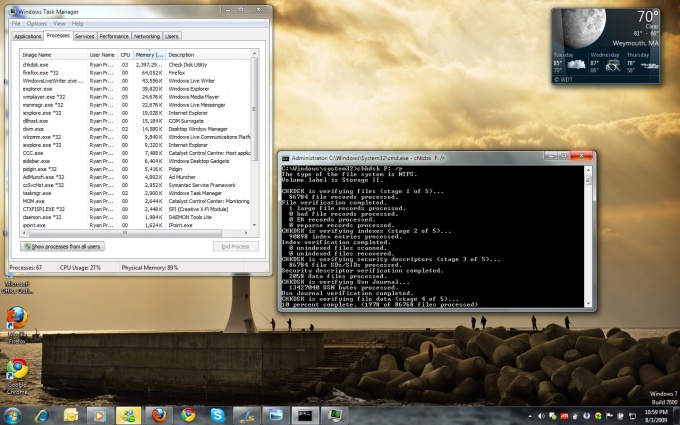
Instructions
Click the "Start" button to enter the main menu and select "My Computer" or open the "My Computer" icon on the desktop.
Select the disk or partition to scan and call service menu right-click on the desired line.
Open Properties and select the Tools tab.
Click the Run button check».
Click the "Run" button in the "Check local disk ()" window that opens.
This will start the non-system check operation hard section disk. Checking the system partition is only possible after rebooting the computer (but before starting the operating system), since system partition is a necessary condition for the functioning of the system itself.
Click the "Scan Schedule" button disk"to set the parameters for scanning the system partition.
An alternative way to run disk scan is to use the command line.
Enter the main menu by clicking the “Start” button and select the “Run” section.
Go to Open and type chkdsk c: /f /r in the command line to check disk WITH:.
Wait until a warning appears about the impossibility of executing the entered command and set the value to Y.
Restart your computer to begin the scan.
If critical disk errors prevent the system from booting, use installation disk Windows for testing.
Produce loading Windows from the installation disk.
Enter chkdsk command c: /r and press Enter to start checking (Windows XP).
Specify required parameters languages and click Next (for Windows Vista/7).
Select the "System Restore" option.
Select "Command Prompt" in a new window with a choice of recovery methods.
Type chkdsk c: /r b press Enter.
note
Be sure to make backup all your data before using third-party utilities!
Disk check – basic function, which is available on Disk checking is carried out at the user's request, using a simple command in the command line window - Chkdsk. The purpose of this tool is simple. With its help, the system will independently search for and correct errors in the file system. If the computer is not performing well enough, the reason may lie in the presence of poorly readable memory sectors and lost clusters. The sudden loss of some files and slow system performance are also symptoms that indicate problems with the file system. In addition, the Chkdsk utility can work in automatic mode, checking the disk for errors every time you turn on the PC. At the same time, the verification time does not last five minutes, but much longer. Of course, users can disable this feature at any time, in which case the user will compromise the integrity of the file system.
How can I disable auto-check of the local disk when Windows starts?
Checking the disk with automatic mode startup is disabled using a couple of operations in the system Windows registry. First of all, you need to click the “Start” button, select the “Accessories” folder in the “All Programs” subsection and click “Run”. A window will appear where you will need to enter regedit and go to the section:
HKEY_LOCAL_MACHINE\SYSTEM\CurrentControlSet\Control\Session Manager. Next, find the Boot Execute function and change the value of this key to the value that suits you best. By default, this parameter has the value “autocheck autochk *”.
The “*” at the end of the inscription is a conditional mark that indicates that the selected disk is being scanned for file system integrity and data consistency. If you add “/K:C” in front of this symbol, then checking the C: drive will be disabled and will not bother the user. After all these manipulations, the Boot Execute key should look something like this:
autocheck autochk /k:C *
Other operations with the registry.
Users have the opportunity to disable scanning of other HDDs; to do this, use the key:
autocheck autochk /k:C /k:D *
After that, HDD check will be disabled, you can roll back the changes made by changing the value of this key to:
autocheck autochk *
Update from 08/28/12
Working on the command line.
It happens that users cannot find the selected key in the registry. In such cases, you should use the command line options. You can enter the command line as follows: “Start”, select the “Accessories” folder in the “All Programs” subsection and click Command Prompt
Disk checking is disabled using the already mentioned Chkntfs command, followed by the key value - /X. Please remember that you need administrator rights to perform this action. So the correct command would look like this:
chkntfs /x d:e:
This means that automatic verification is disabled on two drives. Now all that remains is to restart the computer and enjoy the instant loading of the operating system.
Below, if interested, you can watch a video on how to properly disable disk check at boot. Good luck!




